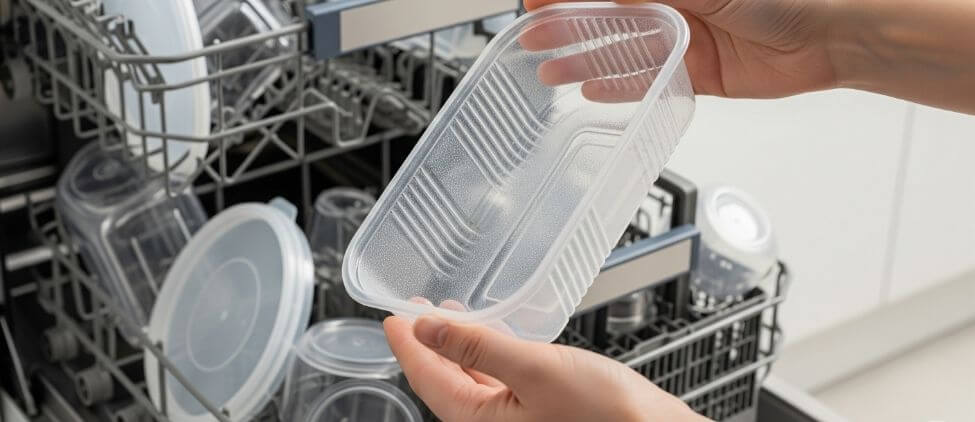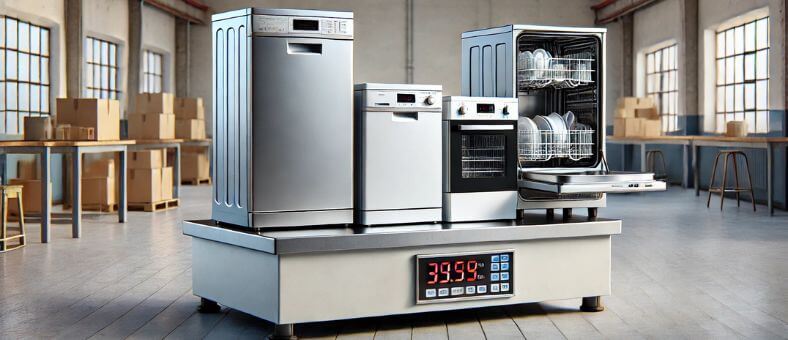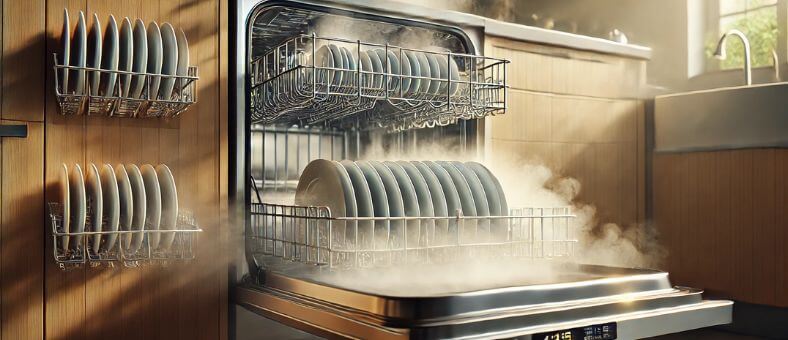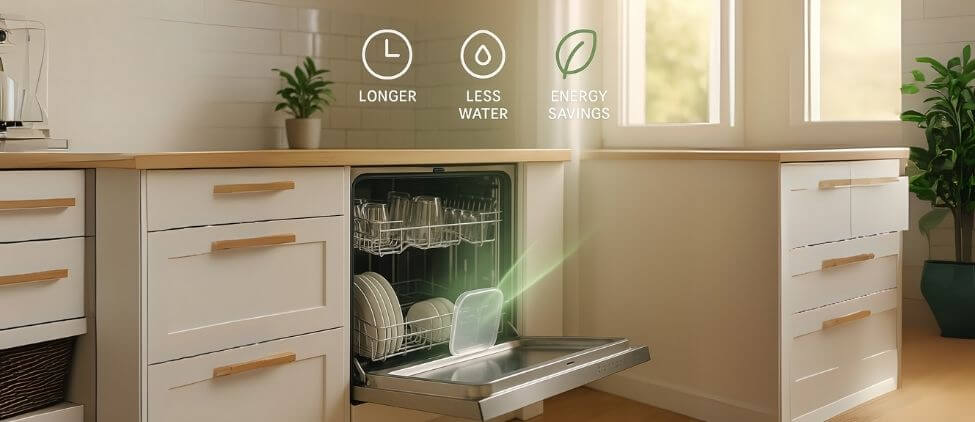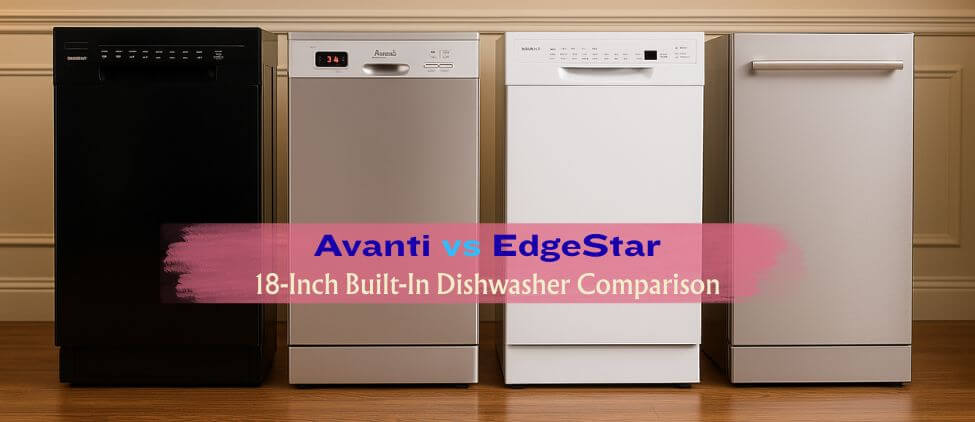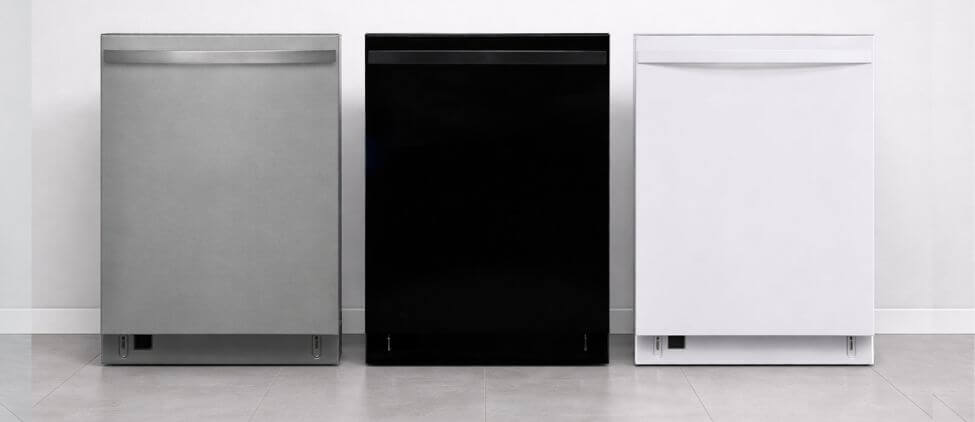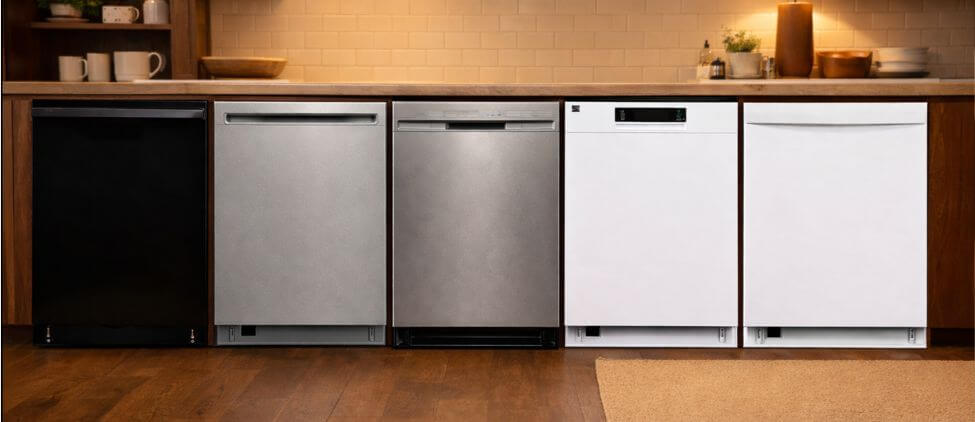Tell me if this sounds familiar: you open the dishwasher after a full cycle, grab a glass that’s bone dry, and then pick up a plastic lid… only for it to drip water right onto your socks. Annoying, right? And the worst part is, you start wondering if you did something wrong, like the wrong cycle, loading, or detergent.
Here’s the truth: it’s not you. Plastics are simply stubborn when it comes to drying. In fact, one of the top complaints dishwasher owners make (after noise and long cycles) is, “Why are my plastics still wet?” The short answer: it’s science, not bad luck.
But here’s the good news: You don’t have to live with soggy Tupperware forever. With a few simple tweaks to your dishwasher’s settings, you can actually get plastics to dry almost as well as glass or steel. And in this guide, I’ll walk you through why plastics misbehave and the 7 settings that actually work to fix the problem.
Table of Contents
Why Plastics Stay Wet in the Dishwasher
So, why do plastics always seem like the problem child of the dishwasher? It comes down to a mix of science and design:
- Low heat retention: Glass and ceramics hold onto heat, which helps water evaporate during the drying phase. Plastics cool down quickly, so the water just clings to the surface instead of evaporating.
- Smooth surfaces: Plastic doesn’t “wick away” water the way textured glass or metal can. Instead, droplets bead up and sit there, waiting for you to wipe them.
- Lightweight material: Plastics don’t absorb much energy from hot rinse water, so they never get hot enough to dry properly.
- Energy-saving dishwashers: Many Energy Star dishwashers skip heated drying to save electricity, which makes plastics the first casualties.
So, it’s not your loading skills (though that can make things worse). Plastics are naturally harder to dry, and unless you adjust your settings, they’ll always come out a little damp.
If you’re curious about what’s safe and what isn’t, we’ve got a complete guide on plastic in the dishwasher: essential insights that explain which plastics belong inside your machine and which ones should stay in the sink.
7 Dishwasher Setting Tweaks That Actually Work
1. Use Extra Dry or Heat Dry
Think of this as giving your dishwasher a little more time under the hairdryer. The Extra Dry (sometimes called Heat Dry or Extended Dry) setting simply adds more heat and more time at the end of the cycle. This helps water evaporate instead of sitting on your plastics like tiny droplets.
- When to use it: Loads that include lots of plastic cups, food containers, or lids.
- What to expect: Cycle runs 20–30 minutes longer, but you’ll notice fewer puddles.
- Trade-off: A bit more energy use, but honestly, it’s worth it when you want to put everything away without a towel.
We compared this in detail in our Extra Dry vs Sanitize guide, which shows exactly when each option makes sense.
2. Try Auto Door-Open or AutoRelease Dry
This one feels like dishwasher magic. At the end of a cycle, the dishwasher door automatically pops open a few inches, letting steam out and fresh air in. That airflow helps water evaporate much faster, especially from plastics that don’t hold heat well.
- Why it works: Steam escaping means less condensation dripping back onto your dishes.
- Where you’ll see it: Brands like Samsung (AutoRelease Dry), Bosch (AutoAir), and Miele (AutoOpen).
- Bonus: It also keeps your dishwasher tub fresher because moisture isn’t trapped inside.
If your dishwasher already has this feature, try it; you’ll be surprised at how much drier your plastics come out. And if you’re curious, we’ve got a full breakdown of dishwasher auto door open and how it works.
3. Activate Sanitize (for plastics that can handle heat)
Here’s a setting many people forget about. The Sanitize option cranks up the temperature of the final rinse (around 150–160°F), which not only kills germs but also helps water evaporate quickly.
- Best for: Baby bottles, pacifiers, sippy cups, or any plastic that’s marked “dishwasher safe.”
- Extra benefit: Peace of mind when someone in the house has been sick.
- Caution: Avoid using it with lightweight or thin plastics that aren’t labeled as dishwasher safe, as high heat can cause them to warp.
This setting uses more energy, but if you’ve got kids or want bone-dry plastic containers, it’s worth the trade-off.
4. Use Rinse Aid Every Time
Rinse aid is like giving your dishes a water-repellent coat. Instead of droplets clinging to plastic, it breaks the surface tension so water slides right off.
- Why it matters for plastics: Since plastics don’t hold heat, rinse aid does the heavy lifting by preventing water spots and speeding up drying.
- When to use it: Always, especially if you’re in a hard water area.
- Quick tip: Don’t wait for the little indicator light to remind you. Keep your rinse aid compartment filled for best results.
If you’re not sure which one to choose, we’ve rounded up the 6 best dishwasher rinse aids for sparkling results that actually work.
5. Load Plastics on the Top Rack
Placement matters more than you think. Putting plastics on the top rack keeps them closer to the warm, drying airflow and away from the hottest heating elements at the bottom.
- Why it works: Better air circulation = faster drying.
- Bonus: Helps protect lightweight plastics from melting or warping.
- Pro move: Tilt cups, bowls, and lids slightly so water doesn’t pool inside.
Think of it like drying laundry outside, you’d spread clothes out to catch the breeze, not pile them in a corner.
6. Combine Quick Wash + Extra Dry
Here’s a neat hack: if you’re short on time but still want dry plastics, pair a Quick Wash cycle with Extra Dry.
- Why it’s smart: You get a shorter overall cycle, but the drying boost makes sure plastics don’t come out dripping.
- Best for: Busy families, late-night loads, or when you just need a few items ready fast.
- Trade-off: Doesn’t sanitize, but for everyday plates and containers, it’s a lifesaver.
7. Avoid Eco Mode (for plastic-heavy loads)
Eco Mode is great for saving energy, but here’s the catch: it usually skips heated drying. And when that happens, plastics stay wetter than ever.
- When to avoid it: Loads with lots of plastics, lunchboxes, or baby items.
- When to use it: For glass, ceramic, or metal-heavy loads where drying isn’t a major concern.
- Solution: Use Normal or Auto cycles with drying options if plastics are involved.
It’s a classic trade-off: energy savings versus dry plastics. Sometimes, convenience wins.
Extra Pro Tips for Plastic Drying
Settings are powerful, but a few small habits can make an even bigger difference with plastics:
- Tilt, don’t stack: Angle lids, bowls, and cups so water slides off instead of pooling inside.
- Shake first: Give lightweight plastics a quick shake before loading, the less water they carry in, the less you’ll be fighting at the end.
- Check for “dishwasher safe” labels: Not all plastics are built to handle heat. If it’s not marked safe, hand-wash to avoid warping.
- Upgrade smartly: Newer dishwashers from Bosch (AutoAir), Samsung (AutoRelease Dry), and Miele (AutoOpen) include special drying systems designed to tackle plastics. If your current machine drives you crazy, this is worth keeping in mind.
- Pair settings with rinse aid: While Extra Dry or Sanitize alone helps, rinse aid takes it to the next level by preventing water from clinging in the first place.
Conclusion
So, here’s the deal: plastics stay wet in the dishwasher, not because you loaded them wrong, but because of how the material behaves. They don’t hold heat; water clings to their smooth surfaces, and modern eco-friendly dishwashers often fail to provide the drying boost they need.
But that doesn’t mean you’re stuck with soggy Tupperware forever. By using settings like Extra Dry, Sanitize, or Auto Door-Open, pairing them with rinse aid, and loading plastics smartly, you can finally open your dishwasher to find dry, ready-to-use containers.
It’s all about knowing which buttons to press, and now you’ve got 7 tweaks that actually work. Next time you hear the cycle end, you won’t be bracing for puddles on your socks.
FAQs About Wet Plastics in Dishwashers
Why do only plastics stay wet, not glass?
Because glass and ceramics hold heat, they dry faster. Plastics cool down too quickly, so water clings instead of evaporating.
Is it safe to put all plastics in the dishwasher?
Not always. Look for the dishwasher-safe symbol. Thin or lightweight plastics can warp under high heat.
Does using Sanitize dry plastics better?
Yes, the higher rinse temperature helps water evaporate. But only use it with dishwasher-safe plastics.
Can I towel-dry plastics after the cycle?
Of course. Many people still give plastics a quick wipe, but with the right settings, you shouldn’t need to do it every time.
Which dishwashers are best for drying plastics?
Models with Auto Door-Open or fan-assisted drying (like Bosch AutoAir or Miele AutoOpen) are usually the best at handling plastics.
Why do my plastics come out wetter in Eco Mode?
Eco Mode skips heated drying to save energy, which leaves plastics wetter than glass or ceramic.
Does rinse aid really make a difference for plastics?
Absolutely. It prevents water droplets from sticking, making plastics dry faster and with fewer spots
You May Also Like
Keeping Your Dishwasher in Top Shape
Regular maintenance is essential to keep your dishwasher operating at its best and lasting longer. Below, you’ll find practical advice from our website to help maintain both cleanliness and efficiency:
- Dishwasher Not Heating Water? Uncover Possible Reasons
- How to Fix a Dishwasher Troubleshooting and Repair
- Dishwasher Problems Caused by Hard Water and How to Fix Them
- Accidentally Put Dish Soap in the Dishwasher? Solutions and Tips
- Dishwasher Air Gaps: What They Are and Why We Need Them
Further Reading to Boost Your Dishwashing Know-How
- Heat Dry vs. Air Dry
- How Do Countertop Dishwashers Work?
- What is a Dishwasher High Loop and Why You Need One
- Dishwasher Cycles and Settings Explained
- How Much Electricity Does a Dishwasher Use?
WashDryDazzle delivers expertly curated lists to help you find the best products for your home. Our detailed guides and expert education articles are crafted to simplify appliance selection and enhance your everyday maintenance routines.

